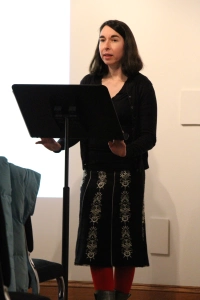Center for Poetry celebrates women’s history with Robin Silbergleid reading
March 29, 2015 - Kelsey Block

The RCAH Center for Poetry and the MSU English Department celebrated Women’s History Month with a reading and workshop by Robin Silbergleid, associate professor of English and director of creative writing at MSU. A small gathering of about fifteen women joined Silbergleid in the RCAH LookOut! Gallery to discuss ekphrasis (the phenomenon of one art form commenting on another) in her work, Frida Kahlo, My Sister, which was published by Finishing Line Press last June.
The title of the book comments on a triangulated relationship between Silbergleid, her sister, and Kahlo. Some of the poems in the book focus on Kahlo’s work, which famously focuses on the female body, while others are written about Silbergleid’s own miscarriages and her sister’s car accident and resulting disability.
In order to make it easy to have a discussion about ekphrasis, Silbergleid presented photographs of Kahlo’s paintings alongside her work at the reading. Still, she said she doesn’t think ekphrastic writing always needs to be accompanied by the piece that inspired it.
“I hope that the poems kind of stand on their own, because they tell the story of the painting,” Silbergleid said, adding that she often talks about ekphrasis in her classes. “Poems should stand on their own as independent works of art, and if I have a student who says, ‘I need to give you this painting,’ the poem’s not working; they haven’t found the language they need to render that image in a new medium.”
Silbergleid said she was first drawn to Kahlo’s work in the early 2000s, around the time she started writing about infertility and reproductive loss.
“They say you read things at the right time, and it was the right moment for me,” Silbergleid said. “I think if I’d seen her work five years before it would have been stunning, but I don’t know that it would have had the same impact on me… Everything was pointing in that direction for me.”
In the conversation after her reading, Silbergleid showed other works of art that focus on the body, such as the work feminist artist Jenny Saville and menstrual art like “Red Is the Color.” In regard to these works, as well as her own writing, Silbergleid said, “There’s no denying that it’s graphic in terms of talking about bodily stuff, but I don’t think it’s excessive or gratuitous. It needs to be there and these are conversations we need to have culturally, but it’s a tricky thing. Art has to take risks, or what’s the point?” she said. Silbergleid’s The Baby Book will be published by CavanKerry Press in November.

